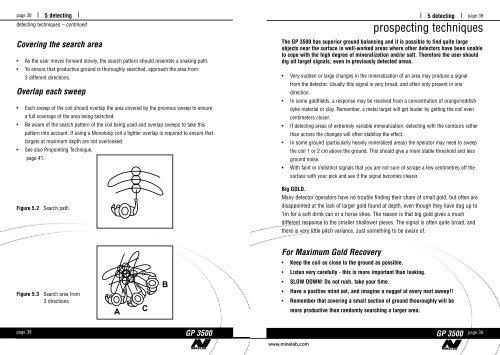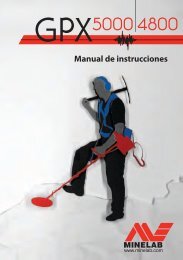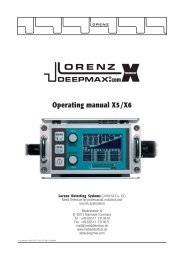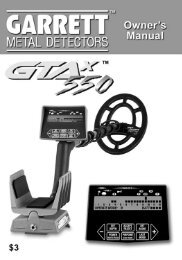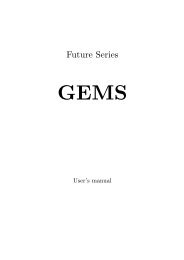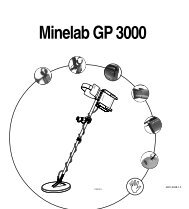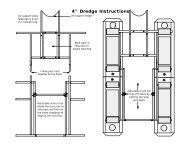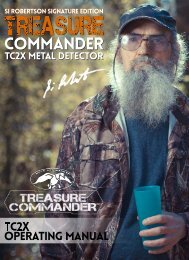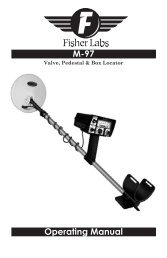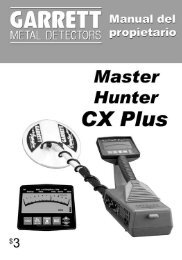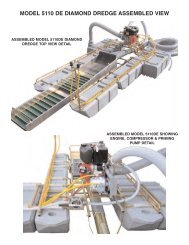page 36 l 4 controls and operation lfront controls – continuedAfter completing the Auto-tune, pick the detector up and with the coil rotated flat, into thesearch position, listen to see if it is stable. If a slight interference is still present, you can usethe manual control to fine tune the selected band.<strong>Manual</strong> Control<strong>Manual</strong> tuning can now be used by the operator to fine tune after the Auto tuning iscompleted. In areas where there is no interference being experienced, the <strong>Manual</strong> controlcan be used to select a personal search band.After completing the auto-tune, to fine tune the band, start turning the manual control quiteslowly in one direction, listening if the threshold becomes more stable or flaky. If this directiondoes not improve it, try the opposite direction. It is quite important that you turn the controlslowly to make very fine adjustments.If the interference persists after tuning, consider using the Coil switch set to Cancel positionand retune againHint: If detecting in a benign area of no interference, you may find that you can select a bandat one end of the scale or the other. Frequency bands in the counter-clockwise ‘start’ directionare lower frequency bands and higher frequency bands are toward the clockwise end. Turnthe control in the desired direction until the one beep or two beep signal is heard. Then usingslow turns in the reverse direction find a band which is stable. This will not make muchdifference but low frequency bands can give a little more depth to larger targets and highfrequency bands can give slightly more sensitivity to smaller targets close to the surface.Important: The manual control will signal when you have moved to the end of therange of frequency bands. When you arrive at the counter clockwise starting pointyou will hear a single beep to denote that this is the start, moving clockwise to theother end, you will hear two beeps to denote that it is the finish.Note – When turning the control rapidly to move to the desiredend you want, you will notice noise caused by the rapidmovement through the frequencies. This is normal andwill not be present when the control is turned slowly.There are 14 turns of the control from start to finish.Hints and techniques for better detecting and happy prospecting that will help you toutilise the power of your <strong>GP</strong> <strong>3500</strong>Some user tips:• Always ensure that the battery is at full charge so that your detector is working atoptimum performance. A worthwhile recommendation is to own a spare battery whichyou can swap half-way through the day thus making sure that you are always workingwith full power.• The battery should be worn in the backpack harness supplied. This places the batteryat the furthest practical distance from the coil.• Ensure that you do not set the shaft length too short. If the coil is too close to yourbody it might detect your pick, the battery or any other metal which you are carrying.Steel toe boots can obviously cause a problem with false signals. If false signals areoccurring as you sweep the coil, check that they are not produced by any metal that youare carrying. Move the coil closer, and then further away from your body, in order tocheck if the signals are coming from items such as your pick, boots or battery. If they are,you must increase the distance between the coil and these items.• Take the time to experiment with the different settings, to fully understand how to get themost out of your detector in different locations.Motion detectionThe <strong>GP</strong> <strong>3500</strong> is a 'motion' detector. Therefore the detector must be movingover a target to detect it.Parallel Sweeping Procedure• The coil should be swept over the ground ina side-to-side sweeping motion.• While sweeping the coil, it is important tokeep it parallel to, and at the same heightfrom, the ground at all times. Lightly skiddingthe coil across the ground can sometimeshelp in this, depending on mineralization.• Do not raise the coil at the ends of eachsweep as this will reduce the detection depthand may cause false signals.l 5 detecting l page 37detecting techniquesFigure 5.1 - Parallel Sweepingpage 36<strong>GP</strong> <strong>3500</strong>www.minelab.com<strong>GP</strong> <strong>3500</strong>page 37
page 38 l 5 detecting ldetecting techniques – continuedCovering the search area• As the user moves forward slowly, the search pattern should resemble a snaking path.• To ensure that productive ground is thoroughly searched, approach the area from3 different directions.Overlap each sweep• Each sweep of the coil should overlap the area covered by the previous sweep to ensurea full coverage of the area being searched.• Be aware of the search pattern of the coil being used and overlap sweeps to take thispattern into account. If using a Monoloop coil a tighter overlap is required to ensure thattargets at maximum depth are not overlooked.• See also Pinpointing Technique,page 41.l 5 detecting l page 39prospecting techniquesThe <strong>GP</strong> <strong>3500</strong> has superior ground balancing and it is possible to find quite largeobjects near the surface in well-worked areas where other detectors have been unableto cope with the high degree of mineralization and/or salt. Therefore the user shoulddig all target signals, even in previously detected areas.• Very sudden or large changes in the mineralization of an area may produce a signalfrom the detector. Usually this signal is very broad, and often only present in onedirection.• In some goldfields, a response may be received from a concentration of orange/reddishdyke material or clay. Remember, a metal target will get louder by getting the coil evencentimeters closer.• If detecting areas of extremely variable mineralization, detecting with the contours ratherthan across the changes will often stabilize the effect.• In some ground (particularly heavily mineralized areas) the operator may need to sweepthe coil 1 or 2 cm above the ground. This should give a more stable threshold and lessground noise.• With faint or indistinct signals that you are not sure of scrape a few centimetres off thesurface with your pick and see if the signal becomes clearer.Figure 5.2Search pathBig GOLD.Many detector operators have no trouble finding their share of small gold, but often aredisappointed at the lack of larger gold found at depth, even though they have dug up to1m for a soft drink can or a horse shoe. The reason is that big gold gives a muchdifferent response to the smaller shallower pieces. The signal is often quite broad, andthere is very little pitch variance. Just something to be aware of.Figure 5.3 Search area from3 directionsFor Maximum Gold Recovery• Keep the coil as close to the ground as possible.• Listen very carefully - this is more important than looking.• SLOW DOWN! Do not rush, take your time.• Have a positive mind set, and imagine a nugget at every next sweep!!• Remember that covering a small section of ground thouroughly will bemore productive than randomly searching a larger area.page 38<strong>GP</strong> <strong>3500</strong>www.minelab.com<strong>GP</strong> <strong>3500</strong><strong>GP</strong> <strong>3500</strong>page 39


